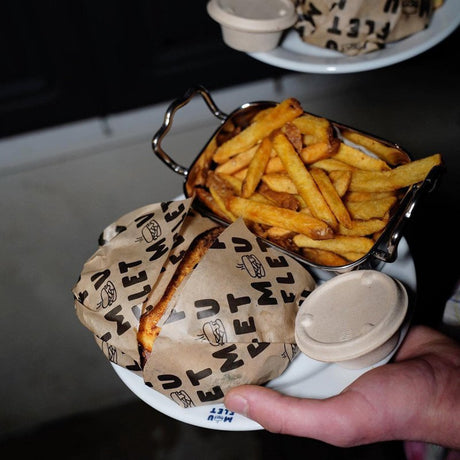Why Compostable Packaging Is Better for the Planet — From Start to Finish
When we think about sustainable packaging, the conversation often ends at one question:
“Is it compostable?”
But there’s more to the story than what happens after your customer finishes their meal. True sustainability means looking at the entire lifecycle of a product — from raw materials to final disposal.
The good news is that compostable packaging options like bagasse, PLA, and kraft paper don’t just break down quickly — they also produce far fewer carbon emissions throughout their journey than traditional plastic packaging.
Bagasse: Turning Waste into Worth
What is Bagasse?
Bagasse is the dry, fibrous byproduct left after sugarcane is crushed for juice. It’s a waste material that would otherwise be burned or discarded.
Why it’s Better
- Uses existing agricultural waste — no need for new crops
- Lower energy input during manufacturing
- Fully compostable in under 90 days (in industrial conditions)
- Home compostable
- No fossil fuel-based inputs
Carbon benefit: Bagasse packaging can generate up to 50% fewer carbon emissions than conventional plastic packaging, depending on processing and transportation.
PLA: Bioplastic with a Smaller Carbon Footprint
What is PLA?
PLA (polylactic acid) is a compostable bioplastic made from renewable resources like corn starch or sugarcane.
Why it’s Better
- Made from renewable plant sources, not oil
- Up to 80% fewer greenhouse gas emissions than petroleum-based plastics
- Lightweight material means fewer emissions during shipping
- Compostable in industrial facilities
Tip: When responsibly sourced and processed, PLA is one of the most carbon-efficient single-use materials available today.
Kraft Paper: Simple, Strong, and Low-Impact
What is Kraft Paper?
Kraft paper is a durable paper made using a pulping process that uses fewer chemicals and less energy than many other paper types.
Why it’s Better
- Less processing means fewer carbon emissions
- Made from recycled or sustainably harvested wood pulp
- Can be recycled or composted
- Biodegrades naturally and safely
Carbon impact: Kraft paper can produce 30–70% less carbon emissions than plastic, especially when recycled or composted properly.
Why the Whole Supply Chain Matters
Sustainability isn’t just about what happens at the end — it’s about every stage of the packaging’s life.
| Lifecycle Stage | Traditional Plastic | Compostable Alternatives |
|---|---|---|
| Raw materials | Fossil fuels | Renewable crops or agricultural waste |
| Production | High emissions and energy use | Lower emissions and energy use |
| Transport | Heavier materials, more fuel | Lighter options, lower fuel use |
| End-of-life | Non-degradable, landfill for centuries | Compostable in weeks or months |
The Bottom Line
Compostable packaging made from bagasse, PLA, and kraft paper isn’t just a responsible end-of-life solution. It’s a low-emission, high-impact choice that reduces environmental harm at every step of the journey.
By switching to compostable materials, your business can:
- Lower its total carbon footprint
- Reduce landfill waste
- Cut reliance on fossil fuels
- Support a more circular and sustainable economy
Looking to make the switch to smarter packaging? We can help you find the right compostable solutions for your business.

